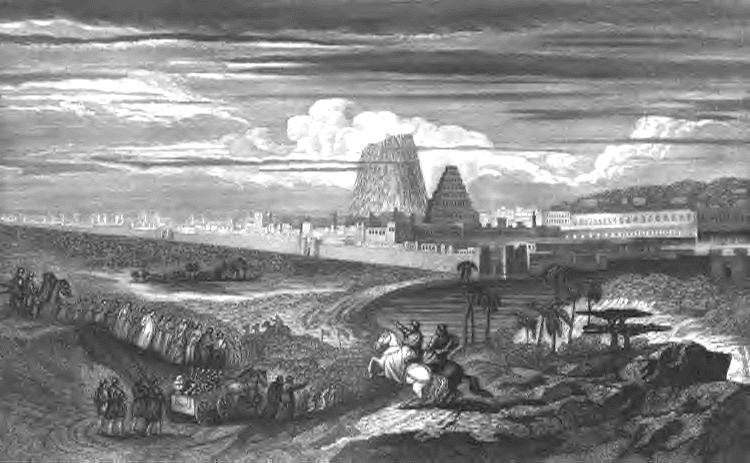
Jerusalem captives taken into Babylon
| Babylon Captivity Number
Contradictions Joseph Francis Alward April 28, 1999 |
|---|
 Jerusalem captives taken into Babylon |
Babylon is the name of an ancient city on the
left bank of the Euphrates river, not far south of the modern Baghdad, where
the Tigris and the Euphrates approach each other most closely. During the
reign of King Nebuchadnezzar (605 - 562 BC) the Babylonians conquered Syria
and Palestine: "And he carried away all
Jerusalem:....none remained, save the poorest sort of people of the land
...Those carried he into captivity from Jerusalem to Babylon."
(2
Kings 24:14-15) The captivity occurred in 598 BC,
and many returned to Jerusalem when Cyrus captured Babylon and set them free
in 538 BC [1]. In the Old Testament books of Ezra and
Nehemiah, the return story is told:Now these are the children...whom Nebuchadnezzar the king of Babylon had carried away unto Babylon, and came again unto Jerusalem and Judah, every one into his city (Ezra 2:1) These are the children...whom Nebuchadnezzar the king of Babylon had carried away, and came again to Jerusalem and to Judah, every one unto his city (Nehemiah 7:5-6)
There are as many agreements as there are
disagreements. The two comparisons below will
We present below two attempted harmonizations of
the alleged contradictions in the census figures. One way around the problem is to claim that the Bible can, indeed, be hard to understand at times, but God understands it, and that's what really counts. God deliberately meant for man to puzzle over the meaning of the words in his book because it builds character and tests the faith of its readers. Just as Jesus spoke in parables so that only the faithful would understand him, then so does God often speak in riddles--sometimes mathematical ones--which only the most faithful can understand; others less diligent and dedicated are destined to be cast into the fires.
Apologists sometimes claim that the figures Ezra
quoted were taken at a different time than Nehemiah's, however, both Ezra
and Nehemiah said that the whole congregation together was 42,360.
(Ezra
2:64, and
Nehemiah
7:66). The agreement between Ezra and Nehemiah about the total number
of returnees is excellent evidence that the data used by Ezra and Nehemiah
came from the same ultimate source, and that there was only one census, not
two. The discrepancies between the numbers in the various families evidently
have arisen because some of the family figures were corrupted.
By the way, readers may verify for themselves that
the actual total of the figures given Ezra is 29,818, while the total in
Nehemiah is 31,089. Thus, while both Ezra and Nehemiah were in agreement
about the exact number of returnees (42,360), neither of them provide the
numbers to support the total. If the Ezra census was a different one from
the Nehemiah one--if indeed there were two censuses, then the total of
both is 29,818+31,089=60,907. But, this figure has to be wrong,
because they each claim the total was 42,360. [2] Cyrus II was king of Persia (modern Iran) (c. 559-530 BC), head of the greatest empire yet to be formed in the ancient world. He assisted Jews in returning to their own land from Babylon, which he captured around 539 BC. "The Handbook of Biblical Personalities", by George M. Alexander, Seabury Press, New York, New York., ibid, page 155. |